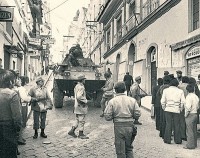Difference between revisions of "Bolivia/1980 coup d'état"
m (Text replacement - "|WP=http" to "|wikipedia=http") |
|||
| (4 intermediate revisions by the same user not shown) | |||
| Line 1: | Line 1: | ||
{{event | {{event | ||
| − | | | + | |wikipedia=https://en.wikipedia.org/wiki/1980_Bolivian_coup_d%27%C3%A9tat |
|image=1980 Bolivian coup d'etat.jpg | |image=1980 Bolivian coup d'etat.jpg | ||
| − | |constitutes=coup | + | |constitutes=coup, US/Sponsored Regime-change efforts since 1945 |
|start=June 1980 | |start=June 1980 | ||
|end=June 1980 | |end=June 1980 | ||
|locations=Bolivia | |locations=Bolivia | ||
| + | |perpetrators=CIA | ||
}} | }} | ||
| Line 14: | Line 15: | ||
==References== | ==References== | ||
{{reflist}} | {{reflist}} | ||
| − | |||
Latest revision as of 20:38, 29 December 2019
 | |
| Date | June 1980 |
|---|---|
| Location | Bolivia |
| Perpetrators | CIA |
The U.S. Department of State categorically denounced accusations of U.S. involvement at the time of the coup, but this does not fit with declassified CIA documents which indicate that on the contrary a decision to intervene in Bolivia was made.[1]
Joël van der Reijden writes about this coup which toppled the previous "cocaine regime" of Hugo Banzer in Bolivia: "The coup is partially made possible because a few months earlier the U.S. inexplicably released a major Bolivian drug trafficker with the name Jose Roberto Gasser, a person with CIA and World Anti-Communist League (WACL) ties. Immediately Gasser and a number of associates, including cocaine kingpin Roberto Suarez of the old Hugo Banzer regime, teamed up with the military to plot the coup against the new democratically-elected government. CIA-linked Argentinian death squads played another key role in the coup."[2]